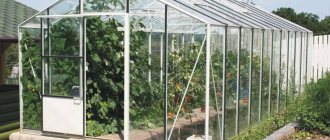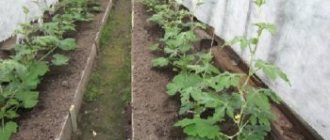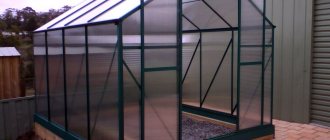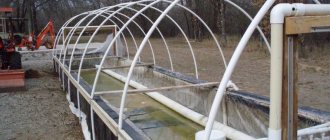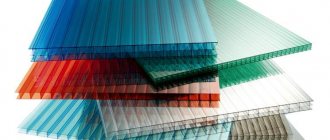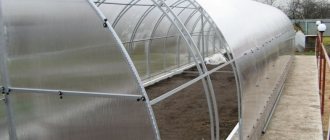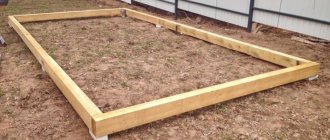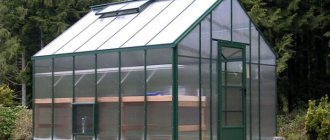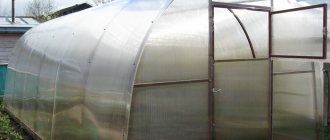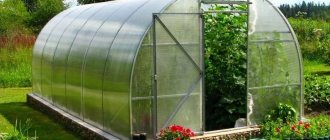Expert selection:
| Model | Price |
| 1. Greenhouse “Dachnaya – Optima” () | from 31,000 rubles |
| 2. Billion April – greenhouse with reinforced frame | from 10600 rubles |
| 3. Greenhouse Very Strong “Square” | from 16,700 rubles |
| 4. Mittlider greenhouse | from 25800 rubles |
| 5. Greenhouse “Dachnaya - Strelka-2.6” () | from 30,000 rubles |
Mini rating (updated in 2022)
What determines the choice of greenhouse?
The durability of a greenhouse depends on the materials used in its construction.
Let's look at the main design elements:
- frame;
- coating material.
Greenhouse shape
For a polycarbonate greenhouse, the most optimal designs will be the following shapes:
- arched shape;
- an equal-wall greenhouse with a gable roof shape;
- cone-shaped;
- spherical shape.
The arched shape of the greenhouse is classic for greenhouses; it is resistant to wind loads. It allows the fullest use of the internal space and has a minimum number of joints, but the frame must have significant strength, since snow can accumulate on the roof due to the arched shape.
Equal-wall greenhouses with a gable roof are more difficult to install. Such greenhouses have the greatest height in the central part and occupy a larger area than others. Cone-shaped greenhouses are best suited for tall plants. The shape of the roof allows snow to melt off easily, but problems may arise with the tightness of the roof ridge joint.
Spherical-shaped greenhouses appeared on the market relatively recently, but are quickly gaining popularity due to their advantages: lightness, mobility, better use of internal volume, illumination, high strength and resistance to various loads - wind, snow, etc., in addition, it is made of -due to its unusual shape, it is perceived as an art object and serves as a real decoration of the site.
An important condition when choosing a greenhouse will be the distance between the arcs - the smaller it is, the stronger the structure. You also need to pay attention to the number of windows, additional doors and the presence of seals. Greenhouses can be stationary or collapsible.
Collapsible ones can be installed on the site in the warm season and deal with the onset of cold weather. Stationary ones do not provide for the possibility of disassembly and re-installation. They can be equipped with a heating system that maintains the required temperature during the cold season.
Coating material
The material used to cover the greenhouse can be different:
- polyethylene film;
- glass;
- polycarbonate
Polyethylene film is the simplest and cheapest coating material. It allows you to create optimal microclimatic conditions in the greenhouse, but along with advantages, it also has disadvantages - the maximum service life of plastic film is 2 seasons, and as a result of heating by sunlight, substances harmful to health are released.
Glass coating is the most environmentally friendly material and has long been used in the construction of greenhouses. It is resistant to heat from sunlight, wind and snow, but there are also disadvantages - fragility, glass can break and cause serious injuries.
Polycarbonate combines the best properties of polyethylene film and glass coating, but the strength of such a coating depends on the shape of the greenhouse and the design of the frame. To protect against ultraviolet radiation, polycarbonate must have an additional layer.
Only transparent polycarbonate can transmit the required amount of sunlight.
The thickness of polycarbonate should be no less than 4 mm and no more than 10 mm. If the thickness is greater, the coating will not transmit sunlight well. The ability to retain heat is affected by the type of coating. It can be monolithic, cellular or profiled.
It is preferable to choose cellular or profiled polycarbonate - it weighs less and has lower thermal conductivity. Profiled polycarbonate due to its structure has greater strength. It is better suited for constructing a durable roof.
It is not recommended to choose polycarbonate with a density less than 0.65 kg/m2, polycarbonate made using recycled raw materials and having a warranty of less than 10 years. This material will turn yellow and crack.
Frame material
The strength of the structure mainly depends on the choice of frame. It must withstand the load from the coating itself and from adhering snow that can accumulate on the greenhouse.
The wooden frame is traditional. It has a low cost and is an environmentally friendly material, but wood also has a number of disadvantages - it is susceptible to rotting. Over time, such a frame will certainly sag.
The aluminum frame is little susceptible to corrosion, is light and easy to process, but under the influence of significant loads arising from stuck snow or strong winds, such a frame can lose shape or collapse.
The steel frame is the most durable and reliable. To protect against corrosion, thermoplastic coating of parts and galvanization of parts are used. The advantages of such a frame also include ease of assembly. Parts of the steel frame can be made from pipes, channels or angles.
What else needs to be considered
And finally, we’ll outline a few more points that need to be taken into account. So, a very important aspect is the shape of the greenhouse. This is especially important for regions where there is heavy snowfall in winter. Due to the heavy snow load, polycarbonate, and even the frame of the greenhouse, can easily break.
The traditional arched model of polycarbonate construction provides a lot of free space inside, but due to its fairly gentle slope, it requires regular cleaning of the roof in winter. The exception is very durable, reinforced greenhouses. An arched model, even the simplest one, is very wind-resistant.
Equal-wall structures with gable roofs also provide a lot of free space inside and can be very high. But they are usually difficult to install. As for the snow, it does not linger on such roofs, and this is already a big plus.
The third option is conical droplet greenhouses. They are optimal for those who grow tall plants. The snow comes off them without much difficulty on their own. But in most cases, this option requires additional sealing of the ridge part.
What else you need to look at:
- the distance between the arcs - the smaller it is, the stronger the greenhouse roof;
- presence of seals included;
- how many doors and windows are there;
- completeness of the set.
How to choose what to pay attention to
The basis of any greenhouse is a frame that must hold not only polycarbonate, but also snow. To prevent the structure from breaking, the following materials are used:
- – wood – environmentally friendly, low cost. Due to contact with wet soil, the lower part begins to rot and sag;
- – aluminum is an easily processed metal and is not exposed to moisture for a long time. The disadvantages include the ability to break in strong winds and snowfall;
- – steel is the most durable material that can last for many years. Cons: high cost, must be treated with anti-corrosion agents (powder paint, zinc coating).
Types of covering materials:
- plastic film - easy to install, but only lasts for 1-2 seasons;
- glass - more often used for industrial cultivation of crops due to its environmental friendliness, resistance to wind and snow. Cons: may break during hail and cause injury;
- polycarbonate - combines the positive properties of glass and film.
An important factor is the shape of the greenhouse. Several designs are suitable for polycarbonate:
- – arched model – characterized by capacity, a minimum number of joints, and is resistant to wind. In winter, snow must be removed from the roof;
- – gable form – this type of greenhouse is difficult to install and takes up more space;
- – cone-shaped – ideal for growing tall plants (cucumbers, tomatoes).
When installing cone-shaped greenhouses, special attention should be paid to sealing the ridge.
Manufacturers rating
When choosing the best greenhouse, it is important to pay attention to the manufacturer. It is better to buy products from trusted brands that are responsible for quality. We have prepared a mini-rating.
Manufacturer. Characteristics. Flaws.
| "Will" | The manufacturer produces polycarbonate and film models, accessories for them, and watering systems. The range is very wide. It has arrow greenhouses, arched, gable and lean-to. The brand produces reinforced and standard designs. The technical documentation indicates the maximum snow load. Models are produced with an opening or solid roof. | Standard models only. |
| "Agrosphere" | Produces models made of polycarbonate on a frame made of steel pipe with powder or double-sided zinc coating. At the buyer's request, windows, ventilation and watering systems, etc. can be installed. The structures can be extended, the length of the extension step is 2 m. Products go on sale in the maximum configuration, which includes small fasteners, legs, etc. | Does not produce foundations; you have to make them yourself. |
| "Innovator" | Novator produces film and polycarbonate greenhouses, greenhouses: from arched structures covered with reinforced film to Mittlider polycarbonate greenhouses. It is possible to produce models according to customer designs. The structures do not require a foundation and are equipped with a weighted support base. The frames are made of profile pipes with a polymer coating. | Sale online only. |
| "Greenhouses of the North" | Models are produced from transparent and colored polycarbonate. A steel pipe, galvanized or uncoated, is used as a frame. Designs with reinforced ends are available; they can better withstand snow loads and do not require additional supports in winter. They have a wide range of standard and custom designs. | Stores are not in all major cities. |
| "New Forms" | Arched polycarbonate models are produced on a frame made of profiled galvanized pipe coated with enamel. To increase strength, double trusses-arcs are used. The package includes seals for sealing the structure; at the buyer’s request, it can be supplemented with a self-ventilation system. The products are designed for installation on a lightweight foundation or leveled area. | Same design, no variety of shapes. |
Assembly instructions
Using a grinder, cut the profile to the required dimensions according to the drawing. The mounting posts are welded around the perimeter to the embedded posts. The usual distance between them is 1 meter.
Then the upper reinforcement is installed. The braces and cross beams are welded to stabilize the structure. When installing a pitched roof, two pipes are cut in the middle with a grinding machine and bent to the required angle at the intersection.
The ridge is cut to the required length and the pipes are welded together. The door frame is also made of pipe and hinges at one end. On the other hand, the window sash is made in the same way.
The main parts of the structure can be welded on a flat surface, after which the finished trusses are installed on the foundation.
The best arched greenhouses of 2022
Greenhouse “Dachnaya – Optima” ()
The greenhouse has won a special place in the hearts of Russian summer residents for its high strength: the domed roof not only helps the snow cover roll off the structure, but can also withstand up to 280 kg per 1 m2.
The basis of the frame is a galvanized metal profile 60x20 mm, the thickness of the profile wall is 1 mm, which allows you to maintain a balance of strength and weight of the structure.. A door is installed at each end - to get into the greenhouse, you don’t need to go around it, and if the weather does not allow you to open doors – vents have been designed to ventilate the building. The width of the structure is standard 3 meters, and the length can be chosen - lengths of 4, 6 or 8 m are available.
How much does it cost - 4*3 m - 24,170 rubles.
Pros:
- robust design
- anti-corrosion profile coating
- the design can withstand a 1.5 m layer of snow
- if desired, you can extend the greenhouse
- holds heat well
- does not require a foundation
Minuses:
- complex assembly
- no sealing tape included
- often the kit does not have enough screws and bolts
Volya Dacha Optima
This greenhouse, according to most gardeners and experts, is recognized as one of the best on the market. Very durable, excellent for wintering on site and withstanding snow loads of up to 280 kg per square meter of surface, this design will last for many years without complaints. The frame is made of durable steel profile 6x2 cm, which does not rust thanks to the zinc coating. The height of the structure is 2.1 m, the width is 3 m, the length is different, and is presented in three variations for areas of different sizes. There are two doors for entry and a pair of vents for effective ventilation. The greenhouse is quite lightweight and does not require preliminary installation of a foundation. Thanks to detailed instructions and a lot of videos on the Internet, you can assemble it yourself. It is also noted that the cost of the product is very reasonable. The main disadvantage is that sometimes there are problems with the packaging; the manufacturer may forget to include part of the fasteners.
Pros:
- reliable design
- no foundation needed
- durable
- withstands heavy snow loads
- the frame does not rust
- nice price
Minuses:
- there are problems with the configuration
Bastion Premium
One of the most durable and long lasting greenhouses on the market. The design is made on the basis of double solid arches, providing it with the ability to withstand heavy snow loads of up to 1 ton. Arc welding is performed using the so-called plasma method. The arcs themselves are made of a pipe with a square cross-section and a thickness of 1.5 mm. The metal is protected from corrosion by powder paint and will last up to 25 years. This greenhouse is very easy to assemble - it only has 20 bolts. The kit includes pins that will allow you to secure the structure to the ground. You can assemble the product yourself within a couple of hours - it’s so simple. The main disadvantage is the difficulty of transportation due to large arcs. But the manufacturer gives a 10-year warranty on its product. Dimensions: width 3 m, height 2.1 m, length varies between 4-10 m.
Pros:
- very strong double frame
- no cracks after assembly
- corrosion protection
- excellent quality fittings
- quick assembly
Minuses:
- difficulties in transportation
Will Yota
This greenhouse is the best value for money and is suitable for small areas. It is very durable - the frame is made of a zinc-coated pipe with a cross-section of 2x2 cm. The arcs are located at a distance of just over 1 m from each other. In short, everything is done to ensure that the greenhouse serves for a long time and can withstand significant loads - up to 560 kg per square of roof. The building has two end doors and two vents to provide ventilation. In addition, the manufacturer provides an 8-year warranty on its products.
Pros:
- very durable
- The optimum ratio of price and quality
- compact dimensions
- no need to clear snow in winter
Minuses:
- narrow
Billion April – greenhouse with reinforced frame
This greenhouse is manufactured in Tyumen. The frame of the greenhouse is made of durable profile or galvanized pipe, which has a cross-section of 20*20 with reinforcement of the upper part. All-welded elements provide additional rigidity. Cellular polycarbonate has a thickness of 4 mm, which is quite durable and reliable. There is a large selection of greenhouse sizes on sale, where the length can be increased.
Pros:
- easy installation
- affordable price
- reinforced frame with additional rigidity
- there are doors and windows
Will Present 220x300 cm
The greenhouse is made of galvanized metal pipes and cellular polycarbonate. If you do not want to use polycarbonate, then the manufacturer suggests purchasing only a frame that you can cover with film. The height of the greenhouse is 2 meters. It is equipped with two doors, which are located at the ends of the greenhouse. The metal frame is resistant to corrosion, so it is not afraid of rain and snow. If the standard length is not enough for you, the greenhouse can be expanded using additional sections.
Pros:
- high quality materials
- presence of two doors
- you can increase the length of the greenhouse
- optimal height
- very durable
Minuses:
- difficult to install
ShelterLogic 240x300 cm
The greenhouse stands on a frame made of metal round pipes with a diameter of 3.5 cm, and it is also equipped with four supporting arches and a reinforced frame. The entire structure is coated with a special DuPont substance, which ensures its resistance to corrosion. The greenhouse is 2.4 meters high, equipped with one door at the end, as well as a durable and reliable door closing mechanism. The greenhouse is covered with a waterproof awning, which can be rolled up if necessary.
Pros:
- reliable design
- does not corrode
- comfortable waterproof awning
- a light weight
- good ventilation system
Minuses:
- high price
- for winter use it will be necessary to replace the awning with cellular polycarbonate
"PC Harvest"
The Harvest PC greenhouse is an excellent solution to the question of how to choose budget structures for growing greenhouse crops. Despite the low price, it has wide functionality and good parameters.
The arched elements are spaced 65 cm apart, providing sufficient rigidity to the entire greenhouse. Polycarbonate sheets are secured using ties that do not damage the integrity of the material. The length of the greenhouse can be different - 4, 6 and 8 m; if desired, you can purchase an additional section and easily attach it near any element. Thus, the question of how to extend the greenhouse does not arise.
The average price of a 3x4 m greenhouse is 12,600 rubles.
Pros:
- cheap
- polycarbonate is not damaged during fastening
- durable
- easy to assemble
- high doors
Minuses:
- may break in winter without supports
- The body is light and may not withstand strong winds
Tulip Premium Antistorm
The rating continues with a greenhouse from a Belarusian manufacturer. This is a fairly new model that went on sale in 2022. The design has been improved and reinforced with rubber seals at all joints with polycarbonate. This minimizes the appearance of condensation on the inside. The roof of the greenhouse has an opening ventilation system. The structure can be installed without a foundation. In this case, it is fixed to the ground with special pins.
| Withstands gusts of wind, m/s | until 22 |
| Frame size, m | 2.02 x 3.08 |
| Frame material | galvanized pipe 40x20 mm |
Price for a frame 4 meters long: from 28,300 rubles.
Pros:
- good ventilation system
- easy assembly
- durable materials
Minuses:
- cannot withstand heavy snow
Kremlin Suite
This greenhouse is also loved by many for its strength, reliability and durability. It is very easy to assemble and the finished structure has no gaps through which cold air would penetrate inside. The greenhouse is based on a durable frame made of 2x2 cm profiled pipe; it has no reinforcements, but is very strong. Easy to assemble and disassemble, forming a level truss. The greenhouse can be installed either on a special foundation or on a soil foundation. The permissible snow load is 250 kg per square area.
The greenhouse is equipped with a pair of doors at the end parts, as well as two vents for ventilation. The model can additionally be equipped with automatic pushers for the vents, which will allow you not to worry about the fact that the greenhouse was not opened in time. But you will need to pay extra for this option. The main disadvantage of this greenhouse is its high cost.
Pros:
- reliable and durable design
- relatively light
- easy to assemble
- high quality frame
- powder coating of the frame
Minuses:
- Expensive
Agrosfera Standard
The rating is completed by an arched greenhouse. The frame is made of pipe with a cross-section of 20x20, completely galvanized. This eliminates the appearance of corrosion and rust and increases service life. The standard length is 4 meters, but it is possible to add modules and extend the greenhouse at any time. Assembly and installation is not difficult; you can do it yourself and do not involve specialists. In winter, it requires regular cleaning of accumulated snow. Adhesion up to 80 kg/sq.m. is acceptable. m, further deformation may occur.
| Polycarbonate, mm | 4 |
| Structure dimensions, m | 2x3 |
| Permissible load, kg/sq.m | 80 |
Price for 4 meters: 15870 rubles.
Pros:
- possibility to extend with modules;
- ease of assembly;
- Installation without foundation is possible.
Minuses:
- requires periodic snow removal;
- insufficient ventilation system.
Uralochka
A polycarbonate greenhouse that receives a lot of positive reviews. It is light, compact, but suitable even for professional gardeners. The metal frame is represented by solid arcs with a cross-section of 3x2 cm, coated with primer-enamel. The model is easy to assemble and easily fixed on the ground. If necessary, you can install a special partition inside and divide the structure into two parts. Disadvantages - the profile of the arcs is too thin (only 1 mm), as well as the inability to withstand a large snow load - in winter the greenhouse must be constantly cleared of snow so that it does not collapse.
Pros:
- easy to use
- solid frame arches
- easy to assemble
- nice appearance
- light
Minuses:
- the frame may rust
- In winter you need to remove snow from the roof
Greenhouse Very Strong “Reinforced”
Very Strong “Reinforced” - this structure demonstrates an excellent balance between budget cost and effective growing of plants in a greenhouse. Despite the affordable price, compared to other offers on the market for goods with similar characteristics, the greenhouse design is functional and has decent dimensions and spacious capabilities.
The greenhouse is installed on a foundation made of wooden beams, which simplifies installation. Arched elements are a double arc - 40x20 mm and 20x20 mm. This ensures the proper level of rigidity of the entire structure and allows it to cope with loads of up to 800 kg/m2. For the manufacture of frame elements, a profile pipe is used with galvanized outer and inner surfaces, which avoids corrosion when dew falls inside the pipes. The coating uses polycarbonate with UV protection. The length of the greenhouse can vary - 4, 6, 8 and 10 m.
The average price of a 3x4 m building is 20,000 rubles.
Greenhouse Very Strong "Reinforced"
Pros:
- increased level of strength due to the use of a double arch
- profile with external and internal galvanization, wall thickness 1.2 mm
- polycarbonate with UV protection
- easy to assemble
- 10 year manufacturer's warranty
Minuses:
- The need to make a foundation
Foundation for a greenhouse
A polycarbonate greenhouse must be installed on a rigid foundation. So, what can become the basis for a polycarbonate greenhouse:
It is worth noting that it is not advisable to lay wood on the ground; it will not last long. Such a foundation can be installed on piles or on a masonry foundation.
Brick laid on a foundation made of strip cement. Such a foundation is durable, but again, if it is laid correctly.
Best Equal Wall Greenhouses of 2022
Equal-wall greenhouses are an excellent solution for growing a large number of tall crops because they allow the height to be increased depending on the needs of the owner. These are large greenhouses that take up the same amount of space on the site as arched greenhouses, but at the same time have a larger internal volume.
Greenhouse Very Strong “Square”
Very Strong “Square” is a suitable proposal for summer residents who are sensitive to the issue of allocating limited space for a greenhouse. Despite its small width, it has a decent internal volume due to straight walls. The arched roof elements are made of a solid 40x20 mm profile pipe, and there are 7 ties to increase the strength and rigidity of the structure. This technical solution allows you to withstand loads of up to 450 kg/m2. The design can be 2 and 2.5 m wide. Length options are 4, 6, 8 and 10 m.
The average price of a 2x4 m building is 15,000 rubles.
Pros:
- large internal volume with small width
- profile with external and internal galvanization, wall thickness 1.2 mm
- polycarbonate with UV protection
- installation is simple
- the manufacturer gives a 10-year warranty
Minuses:
- the need to make a foundation
- limited size range of widths
Mittlider greenhouse
The frame of the greenhouse is made of a solid double arc with a section of 40*20 and 20*20 mm. Thanks to double strength, the structure will be able to withstand a load of a record 778 kg per 1 square meter of area. The manufacturer provides a 10-year warranty on the product. The polycarbonate is a cellular version with a thickness of 4 to 6 mm. Polycarbonate is equipped with an ultraviolet protective film that protects seedlings from the scorching sun.
Pros:
- there is a large selection and size of greenhouse on sale
- reliability and good quality
- polycarbonate is equipped with UV protection
- universal crab system
- many windows
Minuses:
- quite high price
Vintage Classic
This greenhouse model is made in the classic and familiar shape of a house. This feature makes the structure reliable and durable. It can withstand significant loads in winter; snow does not linger on the roof. The inside of the greenhouse is quite spacious, 2.5 meters wide. Plants are easy to care for. The body is reinforced with 9 horizontal bridges. The surface is covered with 4 mm thick polycarbonate. There are doors and vents for ventilation, and you can also install an additional ventilation system in the roof.
| Withstands load, kg/sq.m | 200 |
| Frame | galvanized pipe 25x25mm |
| Dimensions, m | 2.1x2.5 |
Price for the standard version 4 meters long: from 14,790 rubles.
Pros:
- long service life
- withstands snowfalls
- reinforced materials
Minuses:
- foundation required for installation
AGS-Service Botanik Standard
This greenhouse is manufactured by a Belarusian company, and according to the manufacturer, it can serve you for 30 years. Cellular polycarbonate comes in a thickness of 4 to 6 mm, which provides reliable protection for plants and structural strength. The design includes two end doors and vents. The roof slope is designed in such a way that it ensures rapid removal of snow from it.
Pros:
- Beautiful design
- There is a large range of sizes to choose from
- long service life
- rubber compressor
- You can additionally install a window and doors
Minuses:
- high price
- aluminum profile is not reliable and highly durable
Greenhouse "Delta" ()
A building with straight walls and a gable roof. The absence of bent elements makes assembly easier. The frame is made of galvanized profile pipe 20x20 mm, which greatly facilitates the construction. The movable roof eliminates the problem of snow load in winter and facilitates the ventilation process. In addition, there are two doors and two windows. The width of the structure is the usual 3 meters, and the length can be varied - options are available in 4, 6 or 8 m.
The average price of a 3x4 m building is 24,750 rubles.
Greenhouse "Delta" Volya
Pros:
- ease of construction
- sliding roof
- large internal volume
- ease of installation
Minuses:
- the need to make a foundation
- complication of the design due to the sliding roof
Selecting a location
The area on which the greenhouse will be built must be well lit. The best greenhouses are those that are located on hills.
At the very least, melt and rainwater should not flow into this place. If the groundwater is too high, a drainage system must be installed.
A clay area is not suitable for a greenhouse, as water will stagnate here. The ideal soil should be sandy.
You can also make your own sand and gravel bed by digging a hole and filling it with a layer of sand and gravel, then adding fertile soil.
The best cone greenhouses of 2022
Greenhouse "Dachnaya - Strelka-2.6" ()
The teardrop shape of one of the newest models from an old-timer of the greenhouse market allows you to grow plants up to 2.5 m in height inside. But the advantages of this engineering miracle do not end there. The main advantage of Dachnaya - Strelka-2.6 is its high strength. The frame is made of thick galvanized iron that is not subject to corrosion and can support weights of up to 450 kg! The owner of such a greenhouse is no longer afraid of snowy winters.
The average price for a greenhouse 4 m long, 2.6 m wide will be 23,800 rubles.
Pros:
- high strength
- possibility to choose the size (width 2.6 or 3 meters
- beautiful design
- easy assembly
- reliable manufacturing company
Minuses:
- high price
Orange Droplet
This drop greenhouse is an excellent solution for growing tall crops. It has two variations, differing in width - 2.4 and 3 m. The frame has additional strength due to the presence of 8 stringers. In general, the greenhouse has two doors on the end sides and a pair of vents for ventilation. It is very durable and practical, has a simple design, is assembled fairly quickly and can last for a very long time. The only obvious drawback is the need to seal the gaps after assembly that form in the area of the doors and the ridge part.
Pros:
- very durable
- two width options
- nice appearance
- galvanized frame
- light
- nice price
Minuses:
- additional sealing required
Dachna Strelka
A tall and comfortable greenhouse that rightfully occupies a leading position in various ratings. Its height is 2.4 m, and its pointed shape allows you to pay less attention to clearing snow from the roof in winter. And the frame itself is very durable and is designed for a snow load of up to 360 kg per square of roof. The width of the structure is 3 m and it is suitable for most areas. The greenhouse can be placed on a soil foundation without a foundation; it is fixed securely thanks to specially shaped pins. The frame can be disassembled, which allows the product to be transported even in a passenger car.
Pros:
- easy to transport
- durable and reliable
- installed without foundation
- high
- good ventilation
Minuses:
- thin metal frame
Innovator Droplet
Greenhouse designed for installation in northern regions. It is very durable and can easily withstand a large load of snow, which, however, almost does not linger on the roof due to its teardrop-shaped shape. The distance between the frame arcs is 66 cm. The frame itself is made of metal with corrosion protection, the profile has a cross-section of 2x2 cm. This greenhouse is very easy to assemble, since all its parts are informatively marked, and it is difficult to confuse them during installation. The manufacturer also provides a 10-year warranty on polycarbonate.
Pros:
- 10 years warranty
- durable and reliable
- anti-corrosion treatment
- roof vent and plastic barrel included
Minuses:
- Expensive
Greenhouse Very Strong “Droplet”
The gable greenhouse with a ridge on the roof is available in three widths and heights: 2.7x2.5 m; 3x2.4 m; 3.5x3.1 m. The frame profiles are galvanized, which makes it possible to protect against corrosion. An increased level of strength is guaranteed by 7 ties, thanks to which the structure can withstand a load of 340 kg/m2. Polycarbonate is attached to the frame with roofing bolts: gusts of wind no longer pose a danger. A high arch will allow you to grow tomatoes and melons using pins and a tying system, which significantly saves planting space. The maximum length of the greenhouse offered by the manufacturer is the standard 10 m. The design includes 2 vents on the sides as a ventilation system.
How much does a greenhouse with polycarbonate 2.7x4 m cost - 19,000 rubles.
Pros:
- high design, convenient for growing tomatoes and melons
- the frame is durable
- galvanized profiles
- relatively low price
- 10 year manufacturer's warranty
Minuses:
- low snow load
- the ridge is poorly sealed
Whatever greenhouse the buyer ultimately chooses, polycarbonate and its thickness can always be discussed with a consultant separately. If you don’t look at the dacha during the winter, the thicker and denser the polycarbonate is, the lower the likelihood of breakdowns of the vegetable “dwelling”. A good greenhouse will delight the owner for many years not only with its elegant appearance, but also with a significant increase in yield, so you should not skimp on it.
Hacienda-4 Standard
A Russian-made greenhouse with a durable galvanized frame. The cross-section of the pipes is 2.5x2.5 cm, and the thickness of the metal is 1.2 mm. The step between the solid arcs is small, only 65 cm, which suggests an increase in the strength of the product. And the polycarbonate with which the greenhouse is closed has a thickness of 4 mm, there are two options - standard and nano. The width of the structure will allow you to arrange three beds inside. The height is 2.3 m and is suitable for growing tall crops. The greenhouse is easy to assemble. It is suitable for those regions where snowfalls and strong winds are frequent.
Pros:
- very durable
- wide
- thick metal arcs
- solid arches
- optimal ratio of cost and quality
Minuses:
- not detected
"Dubrava" (from Glass House)
This type of greenhouse is more aimed at professional gardeners than at the average owners of summer cottages. The width of the structure is as much as 4 meters, while the standard for a summer cottage is 3. The length can be chosen to your liking, but the minimum is also 4 meters. Despite their large volume, greenhouses of this type are quite compact and do not look overly bulky. The height of the building is as much as 2.8 meters, and there are triangular windows on the roof for ventilation.
Additional ties are built into the frame - they not only give it rigidity, but can also help install additional ventilation, heating elements or lighting wiring. The frame can withstand up to 180 kg of snow per 1 square meter, provided it is even covered with cellular polycarbonate.
The average price for a 4x4 structure is 47,000 rubles.
Pros:
- compactness
- ability to plant very tall plants
- strength
- galvanized corners, handles and doors
- 30 year manufacturer's warranty (applies to frame)
Minuses:
- price
Greenhouse installation
And now, you have purchased all the necessary materials, now the question arises, how to make a greenhouse? Where to begin?
Creating a foundation The basis of any structure is the foundation, and for a stationary greenhouse it is one of the main elements. If you used cement, you need to give it time to harden.
An ordinary construction knife for cutting polycarbonate sheets. It is worth noting that in order for the structure not to deform, the sheets must be fastened at least 1 - 1.2 meters.
Assemble the frame and secure it to the foundation.
Cover the frame of the future greenhouse with polycarbonate sheets. Fasten the sheets with an overlap of 6 - 10 cm or end-to-end using a special profile. To make the structure stronger and more durable, connections must be made on a supporting base.
If you cannot visit the site often enough to water on time, it is necessary to provide the possibility of automatic watering. You also need windows that open and close automatically to maintain the desired climate.
Which polycarbonate greenhouse is better to choose?
Most summer residents think about installing a greenhouse immediately after purchasing land. However, not everyone can make a choice among all the variety. Cost, advantages, disadvantages, shape, coating and much more can vary greatly. That is why it is necessary to answer the following questions:
- For what purposes? For business and help on the farm - large greenhouses, for additional cultivation of several types of vegetables - small ones. Year-round use - stationary, temporary - collapsible.
- Which shape is best suited to natural conditions? The more snow, the steeper the slope.
- Location? How much light, snow and wind will affect the structure? For harsh conditions, it is better to choose reinforced types.
- Frame material? Wooden (constant care, low cost, fragility), plastic (durable, does not rot, low weight, poor thermal conductivity), aluminum (lightweight, rust-resistant, high cost), steel (durability, withstands heavy loads).
Choosing a polycarbonate greenhouse comes down to determining the shape, size and purpose of use. Only after determining the type of frame can you move on to choosing polycarbonate. The optimal thickness should be from 4 to 6 mm (7 mm for the roof).
Pros of using polycarbonate
Unlike glass greenhouses, polycarbonate has more advantages, such as:
Compared to glass, polycarbonate is much stronger. For example, snow in winter can cause glass to crack or even break, while polycarbonate is more resistant to weather conditions.
Less UV penetration means that plants grown in a polycarbonate greenhouse will suffer less burns than in a classic glass greenhouse.
Excellent thermal insulation; Compared to glass, it again retains heat better, since the polycarbonate material is two-layer.
It withstands temperature changes and maximum altitude well. Glass, on the other hand, can break.
When heated, it is a flexible material, making it quite easy to work with and allows for easy drilling. Polycarbonate is available in separate sheets of standard sizes, so the greenhouse can be covered with 3-4 sheets.
Compared to a glass greenhouse, polycarbonate diffuses the sun's rays, so plants do not get sunburned.
Last but not least is the price. A polycarbonate greenhouse will cost much less than a glass one.
Buy or make it yourself?
If doing something yourself is not for you, then, of course, it is better to buy a factory version; ready-made greenhouses are widely available for sale.
But any gardener will tell you that, as a rule, store-bought greenhouses are not durable enough. The structure should be further strengthened and placed on a good foundation.
When constructing a greenhouse independently, each gardener tries to ensure a high margin of safety.
Sources
- https://topsov.com/rejting-teplic-iz-polikarbonata-dlja-dachi/
- https://stroyday.ru/stroitelstvo-doma/pridomovye-postrojki/rejting-teplic-iz-polikarbonata-top-10-populyarnyx-vybiraem-luchshuyu.html
- https://www.ivd.ru/stroitelstvo-i-remont/dacnyj-ucastok/kakaya-teplica-luchshe-vybiraem-po-3-parametram-76841
- https://vyborok.com/luchshie-teplitsyi-iz-polikarbonata-dlya-dachi/
- https://geostart.ru/post/1402
- https://krasnaja-polyana-ski.ru/ogorod/rejting-teplic-iz-polikarbonata.html
- https://tovar-otzyv.ru/obzor-7-mi-luchshih-teplicz-rejting-2019-2020-goda-po-otzyvam-polzovatelej/
- https://ProReyting.ru/oborudovanie/rejting-luchshih-teplits-iz-polikarbonata-top-7.html
- https://1PoMebeli.ru/rejtingi/rejting-luchshih-proizvoditelej-teplits.html
Cons of polycarbonate
But when choosing polycarbonate, you should not forget about the disadvantages of this material:
Polycarbonate is not durable. Constant exposure to sunlight makes the greenhouse more sensitive.
There are a lot of fakes, if you are unlucky enough to buy low-quality polycarbonate, you may have big problems due to its lack of strength. A standard good quality polycarbonate sheet weighs 10 kg; if the sheet weighs less, it may be a fake.
There may be problems with additional heating of the greenhouse. Avid gardeners who would like to extend the harvest year install additional heating in them.
The frame is the basis
In order for the structure to last for a long time, before choosing a greenhouse, you need to carefully evaluate its frame.
Material from which the frame is made
Today, the best material for greenhouses is an aluminum profile - it is environmentally friendly, durable, has high strength, does not corrode and is aesthetically pleasing. We offer a wide selection of greenhouses made of aluminum profiles. For more than 10 years, she has been creating comfort for clients on their sites. Don’t be lazy, go to the website www.teplici-lux.ru and choose a decent greenhouse for yourself.
For polycarbonate greenhouses, the frames are made of metal: pipes or profiles are used.
Advantages and disadvantages of metal pipe construction
When choosing this option, pay attention to its advantages:
- High strength that does not require additional reinforcement.
- Good stability regardless of installation method: on the foundation or on the ground.
Greenhouse frame made of metal pipes Source setka-nn.ru
The disadvantages include the high price and possible difficulties with installation.
Advantages and disadvantages of metal profile structures
The main advantages include:
- Affordable price, which in no way affects the characteristics of the structure.
- Ease of transportation and installation is ensured due to the compactness and lightness of the materials.
See also: Catalog of construction companies that offer installation services for metal structures
At the exhibition there is a sample of a greenhouse www.teplici-lux.ru made from the PROVEDAL aluminum profile.
Greenhouse frame made of metal profile Source obyava.ua
However, it is necessary to take into account that there is also a significant drawback - mandatory reinforcement of the structure is required.
Dimensions of the greenhouse and individual elements
When determining the size of a greenhouse, the first thing to consider is its purpose and planned production volumes. Design work, even in the most simplified version, allows one to calculate the required amount of materials with sufficient accuracy.
The general rules for carrying out this type of activity are as follows:
- It is necessary to establish the length, width and height of this structure. This takes into account the area and configuration of the site and the convenience of working in the greenhouse.
- The angle of the roof slope is determined to ensure spontaneous sliding of snow.
- When determining the size of the doors, it should be taken into account that the person will carry tools and agricultural equipment during the work process. In addition to the entrance, a folding transom is provided in the wall for ventilation of the structure.
- The structure of the frame must be such that the joints between individual sheets of polycarbonate must fall on its elements. This approach allows us to significantly strengthen the structure.
Features of the package
The standard configuration of greenhouses has not only arcs and transverse connecting elements, but also end elements, vents, and doors. It is best to choose an option in which there are doors on both sides and side windows - this is convenient and very practical. In most cases, the side window is an addition to the main structure.
Windows are a mandatory attribute of a quality greenhouse Source teplici-lux
In addition, you should take care of one more nuance: the distance between the arcs. Reliability and strength depend on this indicator. So, for example, at a distance of 0.65 meters (reinforced version), the stability is much higher than at a distance of 1 meter.

